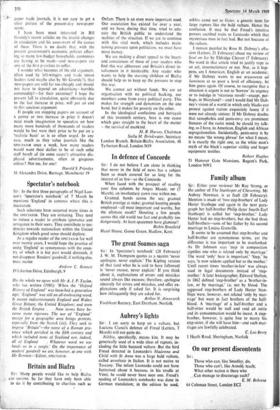Family album
Sir: Either your reviewer Mr Roy Strong, or the author of The Stanhopes of Chevening, Mr Aubrey Newman, is at fault (28 February). Mention is made of 'two step-brothers' of Lady Hester Stanhope and again in the next para- graph her half-brother Philip (later fourth Earl Stanhope) is called her 'step-brother.' Lady Hester had no step-brothers, but she had three half-brothers—sons of her father by his second marriage to Louisa Grenville.
It seems to be assumed that step-brother and half-brother are synonymous terms, yet the difference is too important to be overlooked. As Dr Johnson says 'step in composition signifies one who is related only by marriage.' The word 'only' here is important.' Step,' he says, 'is now seldom applied but to the mother.' Until recent times 'mother-in-law' was always used in legal documents instead of 'step- mother.' A later lexicographer, Edward Shelton, in 1862 defined `step-brother' as a 'brother-in- law, or by marriage,' i.e. not by blood. The supposed step-brothers of Lady Hester Stan- Rope were, however, not related 'only by mar- riage' but were in fact brothers of the half- blood. A 'marriage' of a half-brother and a half-sister would be null and void ab initio and its consummation would be incest. A step- brother, however, is quite free to marry his step-sister, if she will have him—and such mar- riages are lawfully celebrated.
C. Leo Berry 1 Heath Road, Sheringham, Norfolk


































 Previous page
Previous page